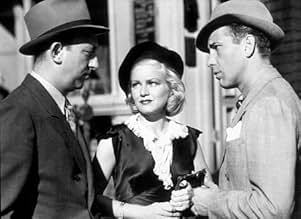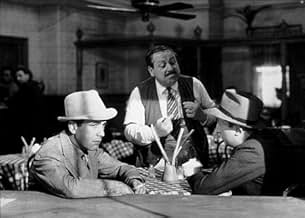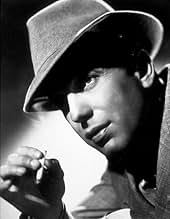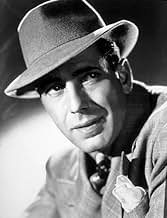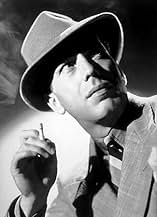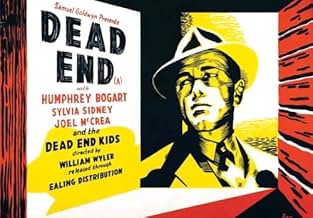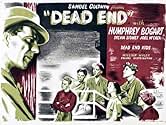PUNTUACIÓN EN IMDb
7,2/10
9,2 mil
TU PUNTUACIÓN
Las vidas de un hombre y una mujer, un famoso gánster, y un grupo de niños callejeros se cruzan en un barrio pobre de Nueva York.Las vidas de un hombre y una mujer, un famoso gánster, y un grupo de niños callejeros se cruzan en un barrio pobre de Nueva York.Las vidas de un hombre y una mujer, un famoso gánster, y un grupo de niños callejeros se cruzan en un barrio pobre de Nueva York.
- Dirección
- Guión
- Reparto principal
- Nominado para 4 premios Óscar
- 1 premio y 4 nominaciones en total
Leo Gorcey
- Spit
- (as Leo B. Gorcey)
Reseñas destacadas
i'm a huge Bogey fan, so naturally i'll watch anything with his name in the credits. however, i was not prepared for "dead end." this is one of the most brilliant films i've ever seen and i can't understand why the eberts and roepers and maltins never talk about this one. it begins as a familiar story, rich vs. poor along the east river. a gang of kids hang around outside the ritzy, new apartments in the neighborhood. tommy, it's leader and his "friends" notice a boy who has been earning pocket money as a babysitter. when tommy steals his money, a fight breaks out. off in the distance, two men in silk suits watch the fight. tommy's sister drina breaks up the fight. drina is a working class woman on strike, trying to earn the money she deserves. Dave is her on-again, off-again love interest who has done everything in the book to try to rise out of poverty, but still can't get ahead. Dave has been seeing Kay, a young woman torn between a future with a man she thinks she may love (Dave) and the comforts of wealth. we find out the two men in silk suits are gangsters, one being the famous killer, baby face martin, who has returned to his home to see his mother and old girlfriend. he is rejected by his mother, who is disgusted by his profession and track record and his girlfriend, who has become a common prostitute. their are a million intertwining story lines that add up to one incredible climax, but essentially this film is about the cycle of poverty and class issues. the performances are terrific. Sylvia Sidney (not a big name today, but a damn good actress) and Joel mccrea are perfection as the films heroes. Bogart is unforgettable. this is one of the dozens of gangsters he played, but i would rate this performances as high as duke manatee in petrified forest. he's tough and street smart, but with each disappointment we see evidence of his emotions leaking out. the gang of kids remind me of the jets in west side story- they don't like anyone, not even each other half the time. look for Marjorie main (ma kettle before she was ma kettle!) in a touching, but heartbreaking scene as Bogey's frail, aging mother and Claire Trevor (another fine, forgotten actress) as Bogey's sweetheart turned greedy streetwalker. the best thing about this film is they way each character believes he or she can overcome the way of life he or she seems fated to live with. each character tries desperately and fails. this is the way real people are. there's no Hollywood, sugar-coatedness about any of it. no over-dramatic music or made-for-the-previews lines. it's grossly realistic. this film would be on my top 50 list, maybe even my top 25. it's that good.
Considering all the talent involved, it was hardly surprising to find this a first rate movie. Didn't you want to slap Bogart around ... well, that is actually what compelled me to make this entry. Among the handful of superlative cameo (say 2 to 8 minutes in length)performances I have seen in my 40 plus years of movie-going, Dead End features one of them.
Marjorie Main, almost as unlikely a film character (think Ma Kettle!) as one could imagine, turned in what I consider a masterpiece. Read that she repeated her stage role, and wow, that slap, that dialog and that role. Bravo!
Marjorie Main, almost as unlikely a film character (think Ma Kettle!) as one could imagine, turned in what I consider a masterpiece. Read that she repeated her stage role, and wow, that slap, that dialog and that role. Bravo!
Dead End is one of my personal favorites, as I watch it 10 or more times a year. The 1930's New York City setting lends itself to a host of interesting perspectives. The talent assembled for this production is why the film withstands the test of time and makes Dead End a movie which I never get tired of viewing. Greg Toland's cinematography is masterful. Max Steiner's musical score is brilliant. He perfectly blended the feel of a fast paced urban theme which then becomes a beautiful and dramatic orchestral piece. Max Steiner had a real genius for bringing the right mood to whatever the film demanded. Of so many brilliant Steiner scores, I find this to be among his finest. William Wyler's direction is awesome, as always. I particularly like the constant background flow of pedestrians going about their day throughout the entire picture. The movie's cast is stuffed with talent. Character actors like Marjorie Mane and Esther Howard fill small segments with memorable scenes. Claire Trevor's portrayal of a sweet girl who became disillusioned and wound up as a prostitute, is poignant while remaining gritty and realistic. The Dead End Kids are great throughout the movie. Ward Bond brings a plus to the movie in his role as the upscale apartment's doorman. I like Allen Jenkins and think no other actor was better suited to play the sidekick to Bogart's character as the prodigal gangster, returning to his old neighborhood. Dead End is one film that has countless elements to enjoy. The level of talent on both sides of the camera keep me watching it over and over again.
The main credit of "Dead End" lies in the stunning visual beauties. The studio reproduction of a New York slum is really magnificent, worth of other major achievements of the same kind, like, say, the set of "Rear Window". A true joy for the eyes. The work of the camera and William Wyler's direction are outstanding, as well. And, of course, the job of the cast is great. Bogart, still in the role of the villain, McCrea and Sylvia Sidney are excellent, and save their rather straightforward characters and lines. In my opinion, the best one is Claire Trevor, in the small part of the lost girl. I normally dislike kids on the screen, but I must concede that here they give great performances, playing the gang of street-boys.
The story is conventional, with a noble message, but few and predictable twists. The script is often clumsy and preachy. Luckily enough, the director gives a quick pace to the narration and inserts a number of humoristic touches. There's a main flaw in the plot: I think that, even in the States of the 1930s, a common citizen couldn't freely shoot a gangster.
Anyway, I've found in the screen-play an interesting and modern theme, namely the psychological ambiguity of some characters, whom even the all-knowing viewer cannot fully understand. For instance, Claire Trevor is apparently the cliche disgraced girl, the innocent victim of poverty, lack of opportunities, social injustice. To end as a prostitute is her unavoidable doom... But, when her former boy-friend Bogie gives some money to help her, she makes the horribly vulgar request of "twenty more bucks"... with a grimace worth of a hardened prostitute (great stuff by Trevor!). So we see that, after all, perhaps that girl is not so innocent as she pretends to be... And what about Drina's brother, the leader of the street-boys? The audience is perfectly aware that, in spite of his whining, weeping self-apologies (when he's in dire straits), the boy is a REAL criminal. We see that he deliberately harms people, steals, brutally thrashes the rich kid, wants to slash his gang-mate. And he just mocks his affectionate sister and his friend McCrea when, in tears, he cries that he's good, that he didn't intend to harm, and all that. So, are we supposed to feel sympathy for this hideous boy? Interesting ambiguity, which creates a fine artistic effect... perhaps beyond the actual intentions of the writer Lillian Hellman.
All in all, we may forgive the defects of the movie. it is worth seeing "Dead End", enjoying the beauty of the set and the work of director and actors.
The story is conventional, with a noble message, but few and predictable twists. The script is often clumsy and preachy. Luckily enough, the director gives a quick pace to the narration and inserts a number of humoristic touches. There's a main flaw in the plot: I think that, even in the States of the 1930s, a common citizen couldn't freely shoot a gangster.
Anyway, I've found in the screen-play an interesting and modern theme, namely the psychological ambiguity of some characters, whom even the all-knowing viewer cannot fully understand. For instance, Claire Trevor is apparently the cliche disgraced girl, the innocent victim of poverty, lack of opportunities, social injustice. To end as a prostitute is her unavoidable doom... But, when her former boy-friend Bogie gives some money to help her, she makes the horribly vulgar request of "twenty more bucks"... with a grimace worth of a hardened prostitute (great stuff by Trevor!). So we see that, after all, perhaps that girl is not so innocent as she pretends to be... And what about Drina's brother, the leader of the street-boys? The audience is perfectly aware that, in spite of his whining, weeping self-apologies (when he's in dire straits), the boy is a REAL criminal. We see that he deliberately harms people, steals, brutally thrashes the rich kid, wants to slash his gang-mate. And he just mocks his affectionate sister and his friend McCrea when, in tears, he cries that he's good, that he didn't intend to harm, and all that. So, are we supposed to feel sympathy for this hideous boy? Interesting ambiguity, which creates a fine artistic effect... perhaps beyond the actual intentions of the writer Lillian Hellman.
All in all, we may forgive the defects of the movie. it is worth seeing "Dead End", enjoying the beauty of the set and the work of director and actors.
In "Dead End" the nominal stars are Sylvia Sidney and Joel McCrea but it is the supporting players that steal the picture. Great performances are turned in by the Dead End Kids (Billy Halop, Huntz Hall, Bobby Jordan, Leo Gorcey, Bernard Punsley), Humphrey Bogart, Claire Trevor and Marjorie Main. It also benefits greatly from the direction of William Wyler who keeps the story moving and makes the characters interesting.
"Dead End" was originally produced on the Broadway stage. The Dead End Kids re-enact their Broadway roles. The story takes place on the banks of the East River in New York where posh apartment buildings co-habit the neighborhood with the tenement slums. The plot centers on the activities of the people of the neighborhood one summer's day.
Dave Connell (McCrea) is a struggling architect looking for his big break. Drina (Sidney) is a struggling shop clerk who is involved in a labor dispute and hopes one day to be able to leave the neighborhood. Gangster "Baby Face" Martin (Bogart) returns to his childhood haunts hoping to see his mother (Main) and hook up with his old girlfriend Francey (Trevor). Hanging around the wharf are a group of teenage toughs (The Dead End Kids) one of whom, Tommy (Halop) is the brother of Drina.
The boys taunt rich kid Philip Griswald (Charles Peck) and lure him down to the street. There he is beaten up by the boys. His father (Minor Watson) is highly influential man who insists on justice for his son. One of the boys, "Spit" squeals on his pal and Tommy is arrested after stabbing Mr. Griswald in the hand.
Meanwhile Martin goes to see his mother and is shocked when she slaps him and calls him a murderer. Martin's pal "Hunk" (Allen Jenkins) locates Francey and arranges for her to come meet "Baby Face". Martin is doubly shocked when he learns that his former love has pursued a career on the streets.
During an altercation with Dave over the influencing of the boys, Martin stabs him and throws him into the river, leaving him for dead. Martin then hatches a plot to kidnap the rich kid Philip Griswald. But Dave returns, confronts Martin and..............
This film is arguably Bogey's best film of the 1930s. Oddly enough, it was made on loan out to Samuel Goldwyn. His expressions of surprise and disgust after meeting with his mother and Francey are a treasure to watch. Trevor's performance, however brief, was moving enough to garner her a best supporting actress Oscar nomination. Marjorie Main also only appears briefly but evokes great sympathy in her role as the tragic Mrs. Martin.
The Dead End Kids to a man turn in what are the best performances in the film. They would go on to appear in a series of Warner Bros films in the next two years before moving into several "B" series in the 40s and 50s. Also, look for Ward Bond as the doorman to the rich apartment building and Don "Red" Barry as an abalones doctor.
An excellent film.
"Dead End" was originally produced on the Broadway stage. The Dead End Kids re-enact their Broadway roles. The story takes place on the banks of the East River in New York where posh apartment buildings co-habit the neighborhood with the tenement slums. The plot centers on the activities of the people of the neighborhood one summer's day.
Dave Connell (McCrea) is a struggling architect looking for his big break. Drina (Sidney) is a struggling shop clerk who is involved in a labor dispute and hopes one day to be able to leave the neighborhood. Gangster "Baby Face" Martin (Bogart) returns to his childhood haunts hoping to see his mother (Main) and hook up with his old girlfriend Francey (Trevor). Hanging around the wharf are a group of teenage toughs (The Dead End Kids) one of whom, Tommy (Halop) is the brother of Drina.
The boys taunt rich kid Philip Griswald (Charles Peck) and lure him down to the street. There he is beaten up by the boys. His father (Minor Watson) is highly influential man who insists on justice for his son. One of the boys, "Spit" squeals on his pal and Tommy is arrested after stabbing Mr. Griswald in the hand.
Meanwhile Martin goes to see his mother and is shocked when she slaps him and calls him a murderer. Martin's pal "Hunk" (Allen Jenkins) locates Francey and arranges for her to come meet "Baby Face". Martin is doubly shocked when he learns that his former love has pursued a career on the streets.
During an altercation with Dave over the influencing of the boys, Martin stabs him and throws him into the river, leaving him for dead. Martin then hatches a plot to kidnap the rich kid Philip Griswald. But Dave returns, confronts Martin and..............
This film is arguably Bogey's best film of the 1930s. Oddly enough, it was made on loan out to Samuel Goldwyn. His expressions of surprise and disgust after meeting with his mother and Francey are a treasure to watch. Trevor's performance, however brief, was moving enough to garner her a best supporting actress Oscar nomination. Marjorie Main also only appears briefly but evokes great sympathy in her role as the tragic Mrs. Martin.
The Dead End Kids to a man turn in what are the best performances in the film. They would go on to appear in a series of Warner Bros films in the next two years before moving into several "B" series in the 40s and 50s. Also, look for Ward Bond as the doorman to the rich apartment building and Don "Red" Barry as an abalones doctor.
An excellent film.
¿Sabías que...?
- CuriosidadesWilliam Wyler gave Claire Trevor an old purse and broken high heel shoes. He had her minimize her make-up and ordered her not to comb her hair when she got up in the morning. He wanted her to look like the downtrodden character she was playing.
- PifiasBaby Face Martin suddenly appears from nowhere and is leaning against a railing as the boys are fighting.
- Créditos adicionalesOpening credits prologue: Every street in New York ends in a river. For many years the dirty banks of the East River were lined with the tenements of the poor. Then the rich, discovering that the river traffic was picturesque, moved their houses eastward. And now the terraces of these great apartment houses look down into the windows of the tenement poor.
- ConexionesFeatured in AFI Life Achievement Award: A Tribute to William Wyler (1976)
- Banda sonoraBoo-Hoo
(1937) (uncredited)
Music by Carmen Lombardo and John Jacob Loeb
Lyrics by Edward Heyman
Played at the upstairs party and sung by Huntz Hall in the street
Selecciones populares
Inicia sesión para calificar y añadir a tu lista para recibir recomendaciones personalizadas
- How long is Dead End?Con tecnología de Alexa
- When did the film open in Chicago?
Detalles
Taquilla
- Presupuesto
- 300.000 US$ (estimación)
- Duración1 hora 33 minutos
- Color
- Relación de aspecto
- 1.37 : 1
Contribuir a esta página
Sugerir un cambio o añadir el contenido que falta

Principal laguna de datos
By what name was Calle sin salida (1937) officially released in India in English?
Responde

